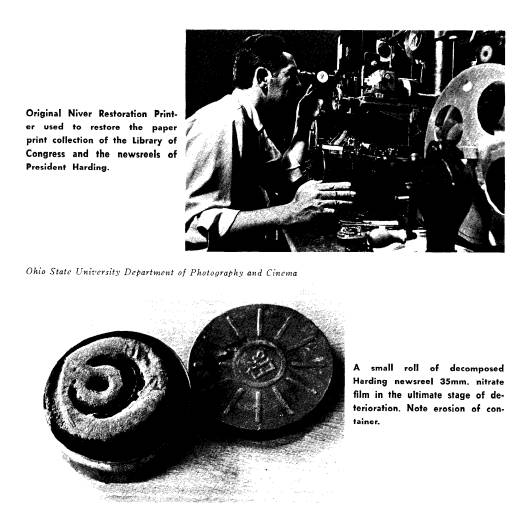Ohio History Journal
ESSAY AND COMMENT
Preservation of the Newsreel Films
of President Harding
by Robert W. Wagner
Efforts of the professional archivist in
his attempt to preserve historical
materials are often complicated by the very nature of
the substance he
is trying to preserve. For example, all
35mm. motion picture film from
1888 to 1951 was made with a cellulose
nitrate base which makes the
reels highly flammable and under some
circumstances highly explosive.
A partially decomposed nitrate film may
ignite spontaneously at 120
degrees F., or even at 105 degrees F.,
if deterioration is far enough advanced.
Another material, triacetate, or so
called "safety" film, was used on 16mm.
and, since 1951, for all 35mm., 70mm.,
and magnetic film and tapes. But
the problem of proper storage of this
film remains. The optimum storage
place for archival films would be in an
airfiltered room at 60-70 degrees F.,
with a relative humidity of 40 to 50
percent. It is now the opinion of the
commerical producers of this film that
black-and-white films should last
as long as high quality paper records,
in proper storage areas.
In 1952 officials of the Library of
Congress, in an effort to find a way
to restore to usefulness its collection
of photographic prints on bromide
paper dating from 1894 that had been
accepted by the United States
Copyright Office as evidence of
ownership of original 35mm. nitrate
motion picture negatives, sought the aid
of the Academy of Motion Picture
Arts and Sciences. Mr. Kemp R. Niver of
the Renovare Film Company in
Hollywood was contacted, and he worked
for more than ten years to develop
a restoration printer. In doing so, he
found it necessary to identify and
solve some twenty-seven separate and
distinctly different technical problems
in the conversion of images from the
opaque bromide paper onto new
16mm. acetate film.
Restoration of archival film in Ohio has
been significantly aided by
the presentation in 1967 of the original
restoration printer made by Niver
to the Ohio State University's
Department of Photography and Cinema.
The first significant task of an
archival nature employing the use of the
new equipment was the project to
preserve the fast-deteriorating 35mm.
newsreel prints of the presidential
years of Warren G. Harding. In 1967,
at the initiative of Daniel R. Porter,
Director of the Ohio Historical
Society and custodian of the film, the
collection of newsreels was removed
from the Ohio State Museum and
transferred to a specially prepared air-
conditioned fireproof room used by the
Department of Photography and
Cinema where cautious handling of the
reels was begun.
